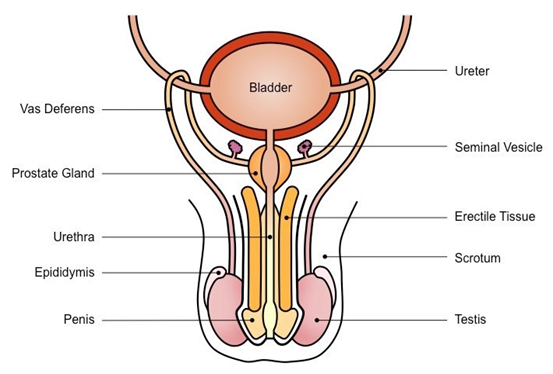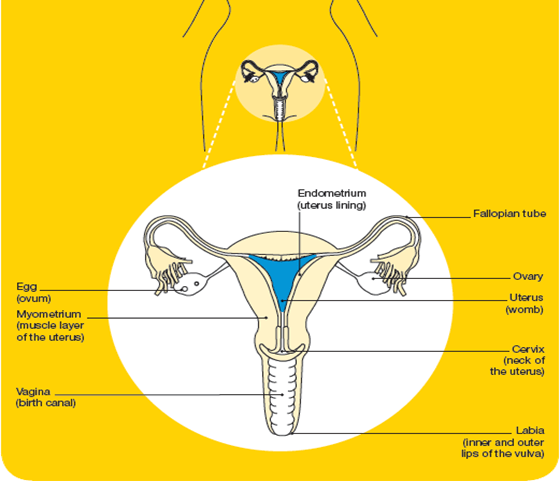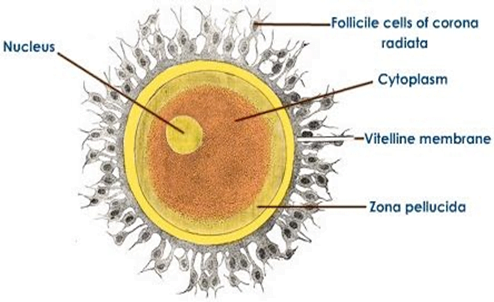REPRODUCTIVE SYSTEM
Most multicellular animals and plants undergo a complex form of sexual reproduction in which especially differentiated male and female reproductive cells (gametes) unite to form a single cell, known as a zygote, which later undergoes successive divisions to form a new organism. The process takes place with the help of the system known as the reproductive system. This system can be divided into.
Table of Contents
- male reproductive system and
- female reproductive system.
STRUCURES AND FUNCIONS OF MALE REPODUCION SYSTEM IN MAMMALS

| STRUCTURE | DESCRIPTION | FUNCTIONS |
| Testis | Oval shaped, found in scrotal sacs in pairs outside the body to enjoy cooler temperature. | – production of sperms
– production of male sex hormones (testosterone) – development of secondary sexual character in male .
|
| Seminiferous tubules | Found within the testis, composed of a mass of sperm producing tubes. | Site of sperm production
|
| Epididymis | Found outside the testis as a long-coiled tube. | Collect and stores sperm temporary till maturity. |
| Vas deferens
(Sperm duct) |
A narrow tube which leads from epididymis to the seminal vesicles. | Conduction of sperm from epididymis to seminal vesicle. |
| Seminal vesicle | A small sac at the back of vas deferens. | – Stores sperm till ejaculation.
– Secretes part of the seminal fluid. NOTE: Seminal fluid contains fructose which provides energy for the sperms. |
| Prostate gland | Connected to the urethra through many tubules. | Secretion of seminal fluid. |
| Cowper’s gland | Located very close to the prostate gland. | Secretes a part of the seminal fluid which raises the acidic ph of the female reproductive medium which otherwise can kill the sperm. |
| Urethra | A narrow tube which passes through the penis. | Aids the passage of sperm into the vagina of the female animal and also passage of urine out of the body hence it is called urinogenital opening. |
| Penis | Contains tissues which makes it turgid (erect when filled) with blood | Helps to introduce sperm into the vagina of the female animal and also passage of urine. |
EVALUATION
- Outline five structural parts of the male reproductive system and their functions
- Why is urethra aurinogenitalopenining?
STRUCTURES AND FUNCTIONS OF THE FEMALE REPRODUCTIVE SYSTEM

| STRUCTURE | DESCRIPTION | FUNCTION(S) | |
| 1 | Ovaries | Found on each side of the vertebra column (two in every woman) | – Produce eggs (ova)
– produces female sex hormone (oestrogen and progesterone) – Development of secondary sexual characters in female. |
| 2 | Oviduct
(fallopian tube) |
A long narrow tube funnel opening which receives eggs released by the ovary and it is a linkage between ovary and uterus. | -Fertilization takes place in the oviduct
– Allows the passage of egg from ovary to the uterus
|
| 3. | Uterus | A muscular organ which is a cavity for development of the zygote into a baby. | – Site of embryo development from implantation till birth
|
| 4. | Vagina | A muscular tube leading from the uterus to the outside of the body. | – It receives sperms from penis during intercourse
-Allows the passage of foetus during birth |
| 5 | Cervix | A ring of muscles with tiny opening that closes the lower end of the uterus where it joins the vagina. | -Controls the opening and closing of the vagina especially during birth. |
| 6 | Vulva | Refers to all external parts of the female reproductive organ. | – Allows the passage of the penis into the vagina during intercourse.
– permits passage of foetus during birth. |
| 7 | Clitoris | A small sensitive organ which correspond to the male penis. It is erectile and becomes stiff when stimulated due to blood inflow | Helps to stimulate female during sexual intercourse (experience orgasm) |
EVALUATION
- State five structural differences between male reproductive system and female reproductive system.
- Describe the organs in the female reproductive system.
STRUCTURE OF MAMMALIAN GAMETES
GAMETE
Gamete is a mature sexual reproductive cell having a single set of unpaired chromosome. It can be male or female gamete. They are formed in the gonads (testis on ovaries) through a process called gametogenesis.
MALE GAMETE

A SPERM
This is called sperm (or spermatozoa) and produced in the male gonads (testis) by a process called spermatogenesis. It is microscopic and unicellular in nature. Usually smaller and more elongated than the egg; about 0.05 mm (0.005 cm) long.
Spermatozoon consists of the following parts:
- Acrosome: It can be found at the upper part of the head, containing lytic enzymes used to dissolve egg membrane to enhance penetration during fertilization.
- Middle piece: It contains mitochondria for the generation of energy used by the sperm for swimming towards the egg.
- Flagellum: The long whip-like tail for propelling the sperm cell
- Nucleus: It can be found in the head of the sperm cell containing genetic materials (DNA-deoxyribonucleic acid) which fuses with the nucleus of the ovum at fertilization.
FEMALE GAMETE

THE OVUM
This is called egg (ovum) and is produced in the female gonad (ovary) by a process called oogenesis. This is larger than sperm, about 0.1mm in diameter.
Each ovum is made up of the following.
- Cytoplasm
- A central Nucleus: It contains the chromosomes which carry the genes.
- Granules and yolk droplets: A source of nourishment for the embryo at the early stage of development.
- Plasma membrane: It surrounds the cytoplasm.
- Outer vitelline membrane and jelly coat of glycoprotein.
Note: The nuclei of the sperm and ovum contains chromosome which carries the gene that are responsible for transmission of characters from parents to offspring.
GENERAL EVALUATION
- What is reproduction?
- Draw a well labeled diagram of the male reproductive organ in mammals.
- List five structural parts of the female reproductive organ in mammals and state their functions.
- State five distinct differences between the male and female reproductive organs in mammals
- Differentiate between the male and the female gametes in mammals.
ASSIGNMENT
SECTION A
- The following are female sex hormone except A. oestrogen B. progesterone C. testosterone D. oxytocin.
- The site of production of sperm is A. epididymis B. seminiferous tubules C. seminal vesicle D. penis.
- Fertilization takes piece in the A. uterus B. vagina C. oviduct D. vulva.
- ____ parts of the male gamete dissolve the egg membrane to enhance penetration A. nucleus B. acrosome C. flagellum D. vitelline membrane.
- The process by which the male and the female gamete are formed in the gonads is referred to as ____ and _____
SECTION B
- Draw a well labeled diagram of the sperm cell and state the functions of the labeled parts.
- Differentiate between sexual and asexual reproduction.
See also:
EXCRETORY SYSTEM IN MAMMALS AND PLANTS
EXCRETION AND EXCRETORY SYSTEM